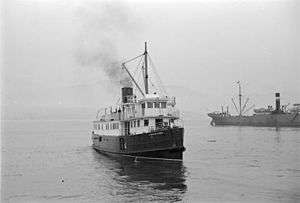Cheakamus (steamship)
Cheakamus was a steamship built in 1913 in North Vancouver, British Columbia. This ship was originally built as the Cheslakee in Scotland. After Cheslakee capsized in 1913, the hulk was raised, lengthened, and placed back into service as Cheakamus.
 Cheakamus in Vancouver harbor, 1925 | |
| History | |
|---|---|
| Name: | Cheakamus |
| Route: | coastal British Columbia |
| Builder: | Wallace Shipyard, North Vancouver, BC |
| In service: | 1913 |
| Out of service: | 1949 |
| Identification: | Canada registry #130309 |
| Fate: | Scrapped 1949. |
| Notes: | Rebuilt and lengthened from Cheslakee following capsize. Converted to towboat in 1942 |
| General characteristics | |
| Type: | coastal steamship |
| Tonnage: | 689 gross; 403 registered tons. |
| Length: | 145.3 ft (44.3 m) |
| Beam: | 28.1 ft (8.6 m) |
| Depth: | 17.0 ft (5.2 m) depth of hold |
| Installed power: | triple-expansion steam engine |
| Propulsion: | single propeller |
| Speed: | 12 knots maximum; 10.5 knots average. |
| Capacity: | Licensed for 148 passengers; cargo capacity 120 tons. |
Nomenclature
Cheakamus was named after the Cheakamus River and Cheakamus Canyon which are north of Howe Sound in British Columbia. The original Skwxwu7mesh (Squamish) name is Chiyakmesh or "Chehagamus", meaning "fish trap."[1]
Construction
In January 1913 the Union Steamship Company's Cheslakee capsized at the dock at Van Anda, British Columbia on Texada Island, drowning at least seven people. The hulk was raised and brought to North Vancouver, BC, where it was cut in half and a new section inserted, thus extending the vessel's length by slightly less than 20 feet.[2] The ship was renamed Cheakamus and returned to service in June 1913.
Cheakamus had a gross tonnage of 689 and net tonnage of 403. The ship was 145.3 feet long, with a beam of 28.1 feet and depth of hold of 17.1 feet.[3] The power plant consisted of a MacColl and Company triple-expansion steam engine.[4] The ship had a speed maximum speed of 12 knots but generally cruised at 10.5 knots.[4] Unlike the Cheslakee, the Cheakamus was stable in heavy seas.[5]
The ship was licensed to carry 148 passengers.[3] The ship had a cargo capacity of about 120 tons.[3] The official Canadian registry number was 130309.[6]
Operations
Originally Cheakamus was used on freight and passenger routes with the Cassiar until 1925 when the newly built Cardena and Catala took over these duties.[7] After that Cheakamus was primarily used to provide service to coastal logging camps.[7][8] In August 1917, Cheakamus was assigned to the route from Vancouver to Alert Bay when the normal vessel on the route, Cassiar struck a rock at Kingcome Inlet and sank.[9]
In the late 1930s, the company modernized the passenger accommodations on Cheakamus with the objective of using the vessel on more routes.[10]
Transfer to U.S. Army
When the United States entered the Second World War in December 1941, there arose a big demand for barge service to Alaska. In 1942, Cheakamus was converted to a towboat.[11] The ship was then purchased by the U.S. Army and used in war transport until the end of the war.[7] The ship was then sold as war surplus to Arthur Foss of the Foss Tug concern.
End of service
In 1949, Foss donated the Cheakamus to the Puget Sound Maritime Historical Society for use as a floating headquarters and museum.[7] However the society decided that the maintenance costs for the vessel would be too great and turned it over for scrapping.[7]
Notes
- Rushton, Echoes of the Whistle, at page 141.
- Rushton, Whistle Up the Inlet, at page 69.
- Rushton, Whistle Up the Inlet, at page 212.
- Henry, The Good Company, at page 145.
- Henry, The Good Company, at page 51.
- The New Mills' List, “Registered Canadian Steamships 1817-1930 over 75 feet” Archived October 3, 2011, at the Wayback Machine (accessed 05-18-13).
- Newell, ed., McCurdy Marine History, at page 564.
- Henry, The Good Company, at page 146.
- Rushton, Whistle Up the Inlet, at pages 77-78/
- Rushton, Whistle Up the Inlet, at page 133.
- Rushton, Whistle Up the Inlet, at page 141.
References
- Henry, Tom, The Good Company – An Affectionate History of the Union Steamships, Harbour Publishing, Madeira Park, BC (1994) ISBN 1-55017-111-9
- Newell, Gordon R., H.W. McCurdy Marine History of the Pacific Northwest, Superior Publishing, Seattle WA (1966).
- Rushton, Gerald A., Whistle up the Inlet – The Union Steamship Story, J.J. Douglas, Vancouver, BC (1974).
- Rushton, Gerald A., Echoes of the Whistle - An Illustrated History of the Union Steamship Company, Douglas & McIntyre, Vancouver, BC (1980) ISBN 0-88894-286-9